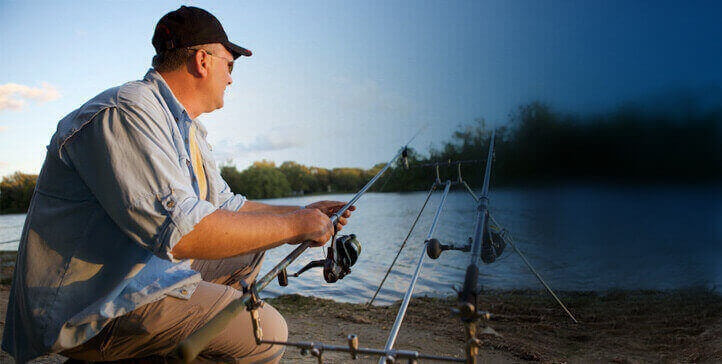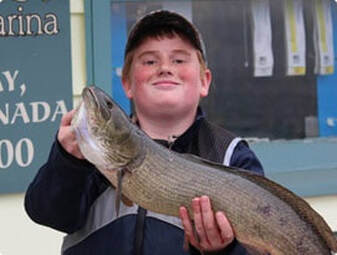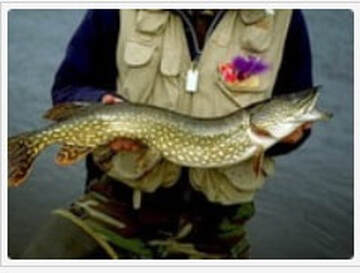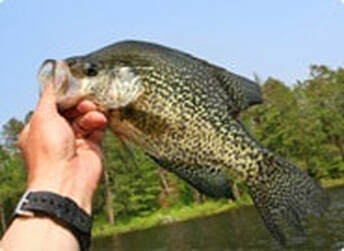|
WE HAVE THE ANGLES FOR ALL YOU ANGLERS!
Fishing! Seeley’s Bay was voted the 5th ultimate fishing town in Canada in 2010 by the World Fishing Network. There is an enormous Large Mouth Bass population as well as plenty of Small Mouth Bass, Northern Pike, Crappie, millions of pan fish and do not forget the Bowfin. |
|
One of only a handful of spots in Eastern Canada where you can fish Bowfin or ‘The Dogfish’. The Bowfin dates back to the Jurassic period over a million years ago; this fish swam with the Dinosaurs! For tips and tricks to catching the Bowfin or any other fish found in Seeley’s Bay, stop in and talk to Roger White or his son, Shane White at the Rideau Breeze Marina. The current Ontario record for largest bowfin was set here in Seeley’s Bay. The bowfin, Amia calva, is the last surviving member of the order Amiiformes (which includes 3 additional, now-extinct families dating from the Jurassic, to the Eocene), and of the family Amiidae (which contains numerous species in about four subfamilies, only one of which, Amiinae, is extinct).
|
The Bowfin is a freshwater piscivore, preying on fish and larger aquatic invertebrates by ambush or stalking. Native to southeastern Canada and eastern United States, they prefer shallow, weedy waters of lakes or protected back waters of rivers. Bowfin are able to breathe air, using their swim bladder, which is connected to their gastrointestinal tract and allows them to regulate their buoyancy in the water, as a primitive lung. The fish can be seen coming to the surface and gulping air. This limits them to a specific depth range in which the surface is accessible. They tend to utilize shoreline habitats that are not accessible to other predatory fish. The most distinctive characteristic of the bowfin is its very long dorsal fin consisting of 145 to 250 rays, and running from mid-back to the base of the tail. They can grow up to 109 centimetres (43 in) in length, and weigh 9.75 kilograms (21.5 lb). Other noticeable features are the black “eye spot” usually found high on the caudal peduncle, and the presence of a gular plate. The gular plate is a bony plate located on the exterior of the lower jaw, between the two sides of the lower jaw bone.
The bowfin is an indiscriminate predator that readily preys on a broad variety of arthropod and vertebrate prey, from insects and crawfish to other fish and frogs.
The male bowfin exhibits extensive parental care. The male clears an area in the mud for the female to lay eggs in, and then fertilizes them. He hovers nearby and aggressively protects the eggs and the fry after they emerge. Bowfin are usually not considered a good food fish compared to more popular freshwater gamefish species, such as pike or bass. They will occasionally strike – and sometimes ruin with their powerful jaws – artificial lures, but they generally strike on live or cut fishes. When hooked, Bowfin fight powerfully. Bowfin should be handled carefully, as they have very sharp teeth. They will continue to struggle even when pulled out of the water. The list of local and alternate names the bowfin is known by is lengthy, but common ones include “dogfish”, “mudfish”, “grindle” (or “grinnel”),”swamp muskie”, “black fish”, “cottonfish” “swamp bass”, “poisson-castor”, “Speckled Cat” “beaverfish”, “Cypress trout”, “lawyer” and “choupique”. Commercially, bowfin are harvested primarily for their eggs as caviar.
The bowfin is an indiscriminate predator that readily preys on a broad variety of arthropod and vertebrate prey, from insects and crawfish to other fish and frogs.
The male bowfin exhibits extensive parental care. The male clears an area in the mud for the female to lay eggs in, and then fertilizes them. He hovers nearby and aggressively protects the eggs and the fry after they emerge. Bowfin are usually not considered a good food fish compared to more popular freshwater gamefish species, such as pike or bass. They will occasionally strike – and sometimes ruin with their powerful jaws – artificial lures, but they generally strike on live or cut fishes. When hooked, Bowfin fight powerfully. Bowfin should be handled carefully, as they have very sharp teeth. They will continue to struggle even when pulled out of the water. The list of local and alternate names the bowfin is known by is lengthy, but common ones include “dogfish”, “mudfish”, “grindle” (or “grinnel”),”swamp muskie”, “black fish”, “cottonfish” “swamp bass”, “poisson-castor”, “Speckled Cat” “beaverfish”, “Cypress trout”, “lawyer” and “choupique”. Commercially, bowfin are harvested primarily for their eggs as caviar.
|
SMALL AND LARGE MOUTH BASS
There is NO DOUBT that it is the bass that keep anglers returning to our community year after year. Opening day of bass season is awaited with much anticipation, and the public dock is busy from first light. Traditionally the local Legion has a derby on opening day (insert link), and then there are a series of tournaments for the rest of the season, including a semi annual visit from the well known Renegade Bass group out of Ottawa (link). Bass is a name shared by many different species of fish. The term both encompasses freshwater and marine species. All belong to the large order Perciformes, or perch-like fishes, and in fact the word bass comes from Middle English bars, meaning “perch.” |
The temperate basses, such as the striped bass (Morone saxatilis) and white bass (M. chrysops), belong to the family Moronidae. The black basses, such as the largemouth bass (Micropterus salmoides), smallmouth bass (M. dolomieu), spotted bass (M. punctulatus), Choctaw bass (M. haiaka), and Guadalupe bass (M. treculii), belong to the sunfish family, Centrarchidae. Small mouth and largemouth bass are plentiful in the Seeley’s Bay area, and particularly when the water is cooler (fall), they make for great eating.
|
CRAPPIE
Nothing says ‘spring is here’ in Seeley’s Bay, like the arrival of crappie fishing. There is often still ice on the bay, when anglers cluster along Dean’s Lane or other places where water is moving close to shore. Crappies are a genus, Pomoxis, of North American freshwater fish in the sunfish family Centrarchidae. The common name (also spelled croppie or crappé), derives from the Canadian French crapet, which refers to many different fishes of the sunfish family. Other names for crappie are papermouths, strawberry bass, speckled bass or specks, speckled perch, calico bass, sac-au-lait (in southern Louisiana, lit “bag of milk”)and Oswego bass. |
Both species of crappie (white and black) as adults feed predominantly on smaller species, including the young of their own predators (which include the northern pike, muskellunge, and walleye). They have diverse diets, however, including zooplankton, insects, and crustaceans. By day, crappie tend to be less active and to concentrate around weed beds or submerged objects, such as logs and boulders; they feed especially at dawn and dusk, moving then into open water or approaching the shore. Angling for crappies is popular throughout much of North America. Methods vary, but among the most popular is called “Spider Rigging,” a method characterized by an angler in a boat with many long fishing rods pointing away from the angler at various angles like spokes from a wheel. Anglers who employ the Spider Rigging method may choose from among many popular baits, like corn. Some of the most popular are plastic jigs with lead jig heads, crankbaits or live minnows
|
SUNFISH
Everyone can catch a sunfish, and a lot of Seeley’s Bay area families have introduced their children to the love of fishing by letting them catch sunfish at the dock…it’s impossible to not catch one, and that first catch brings a guaranteed grin to most children. Generally people practice catch and release with sunfish, but they can be a tasty panfish if you are so inclined. The sunfishes are a family (Centrarchidae) of freshwater ray-finned fish belonging to the order Perciformes. The type genus is Centrarchus (consisting solely of the flier, C. macropterus). |
The family’s 27 species include many fishes familiar to North Americans, including the rock bass, largemouth bass, bluegill, pumpkinseed, and crappies. All are native only to North America. Family members are distinguished by having at least three anal spines. The dorsal spines are 5–13 in number, but most species have 10–12. The pseudobranch is small and concealed. Sizes of most are in the 20 centimetres (7.9 in) to 30 centimetres (12 in) range. However, some are much smaller, with the blackbanded sunfish at just 8 centimetres (3.1 in) in length, while the largemouth bass is reported to reach almost 1 metre (3.3 ft) in extreme cases. The male of most species builds a nest by hollowing out a depression using his tail, then guards the eggs. Most sunfishes are valued for sports fishing, and have been introduced in many areas outside their original ranges, sometimes becoming invasive species.




